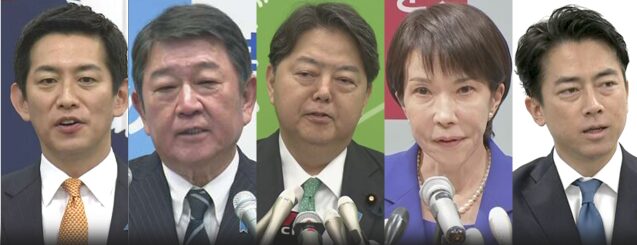Japan’s ruling Liberal Democratic Party has launched a high-stakes leadership contest to choose a successor to Prime Minister Shigeru Ishiba, who is stepping down after a series of electoral losses and eroded public trust. The contest is scheduled for October 4, and its winner will almost certainly become Japan’s next Prime Minister, given the LDP’s position—even as it now governs as a minority.
There are five candidates in the running, all current or former ministers, each staking out different priorities:
-
Shinjiro Koizumi, 44, seen as the reformist frontrunner. He promises strong action on boosting wages to outpace inflation, economic growth, support for productivity, and policies to ease cost pressures—such as cutting gasoline taxes and raising household tax exemptions.
-
Sanae Takaichi, veteran conservative lawmaker, aiming to become Japan’s first female prime minister. Her platform leans toward fiscal stimulus, economic security, and preserving traditional conservative values.
-
Yoshimasa Hayashi, currently Chief Cabinet Secretary, presenting himself as a candidate of stability and economic balance. He supports gradual interest rate hikes by the Bank of Japan and seeks to avoid extremes in policy.
-
Toshimitsu Motegi, former Foreign Minister and established LDP figure, who emphasizes diplomatic strength and institutional credentials.
-
Takayuki Kobayashi, former Economic Security Minister, whose appeal is more limited; his proposals include tighter immigration controls and temporary tax cuts among others. He is viewed more as an underdog.
The race is more than just a choice of who leads—it reflects a deeper struggle inside the LDP between the “old guard” conservatives who want to double down on traditional policy and security priorities, and a younger or more reform-oriented faction pushing for economic modernization, responsiveness to inflation and cost of living, plus more openness in governance.
The stakes are high: the LDP’s recent electoral setbacks have left the party without a majority in either house of parliament. That means the next leader will need to work harder than usual to build coalitions or at least secure support beyond the party to pass legislation and maintain stability. Public expectations are rising, particularly around inflation, wage stagnation, demographic decline (especially the aging population and low birthrate), and international pressure from trade, climate, and security challenges.
In polls so far, Koizumi and Takaichi lead among LDP rank-and-file and the public. But Hayashi is also seen as a serious candidate for those voters wanting steadier, less disruptive leadership. Motegi and Kobayashi trail, but could play key roles in influencing the policy debates.
Whoever wins this internal fight will shape Japan’s policy direction for years: how it deals with inflation, structural reforms, foreign relations (especially with China, the U.S., and in Asia more broadly), and how it handles its shrinking population and fiscal pressures. The LDP slogan for the race, “Change, LDP,” underscores just how strongly many inside believe change is necessary.

